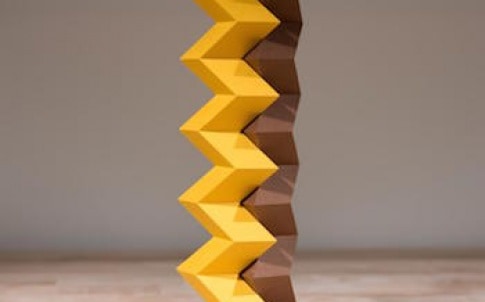The team, made up of researchers from the University of Illinois at Urbana-Champaign, the Georgia Institute of Technology and the University of Tokyo, say the method could be applied to other thin materials, including plastic or metal, to transform structures from furniture to buildings to microscopic robots.
Illinois graduate researcher Evgueni Filipov, Georgia Tech professor Glaucio Paulino and University of Tokyo professor Tomohiro Tachi published their work in the Proceedings of the National Academy of Sciences.

Paulino sees particular potential for quick-assembling emergency shelters, bridges and other infrastructure in the wake of a natural disaster.
“Origami became more of an objective for engineering and a science just in the last five years or so,” Filipov said in a statement. “A lot of it was driven by space exploration, to be able to launch structures compactly and deploy them in space. But we’re starting to see how it has potential for a lot of different fields of engineering. You could prefabricate something in a factory, ship it compactly and deploy it on site.”
The researchers have used an origami technique called Miura-ori folding. They make precise, zigzag-folded strips of paper, then glue two strips together to make a tube. While the single strip of paper is highly flexible, the tube is stiffer and does not fold in as many directions.
The researchers tried coupling tubes in different configurations to see if that added to the structural stiffness of the paper structures. They found that interlocking two tubes in zipper-like fashion made them much stiffer and harder to twist or bend. The structure folds up flat, yet rapidly and easily expands to the rigid tube configuration.
“The geometry really plays a role,” said Paulino, a former Illinois professor of civil and environmental engineering. “We are putting two tubes together in a strange way. What we want is a structure that is flexible and stiff at the same time. This is just paper, but it has tremendous stiffness.”
The zipper configuration reportedly works even with tubes that have different angles of folding. By combining tubes with different geometries, the researchers can make many different three-dimensional structures, such as a bridge, a canopy or a tower.
“The ability to change functionality in real time is a real advantage in origami,” Filipov said. “By having these transformable structures, you can change their functionality and make them adaptable. They are reconfigurable. You can change the material characteristics: You can make them stiffer or softer depending on the intended use.”
The team used paper prototypes to demonstrate how a thin, flexible sheet can be folded into functional structures, but their techniques could be applied to other thin materials, Filipov said. Larger-scale applications could combine metal or plastic panels with hinges.
Next, the researchers plan to explore new combinations of tubes with different folding angles to build new structures. They also hope to apply their techniques to other materials and explore applications from large-scale construction to microscopic structures for biomedical devices or robotics.
The paper “Origami tubes assembled into stiff, yet reconfigurable structures and metamaterials” is available from PNAS.





Glasgow trial explores AR cues for autonomous road safety
They've ploughed into a few vulnerable road users in the past. Making that less likely will make it spectacularly easy to stop the traffic for...